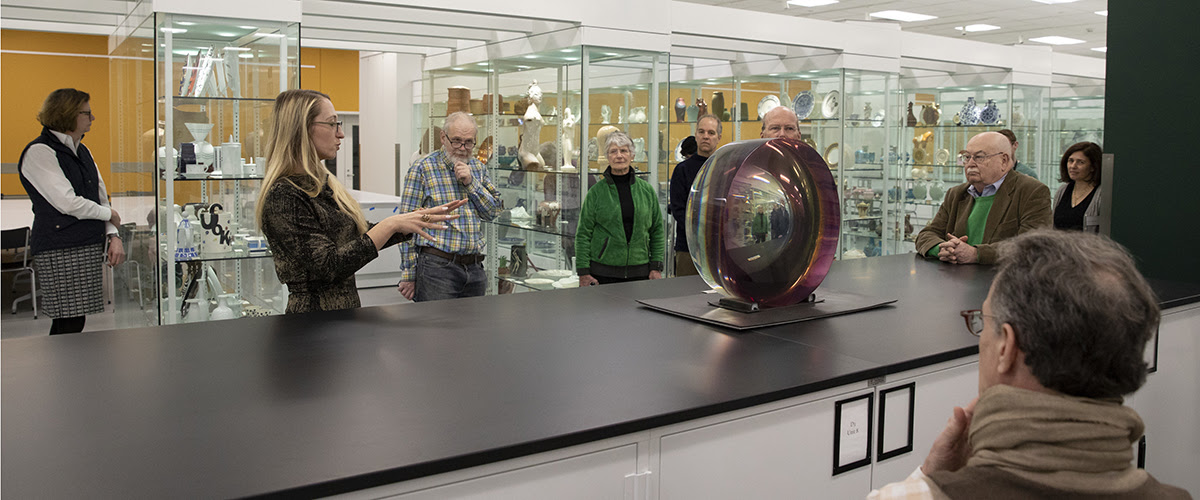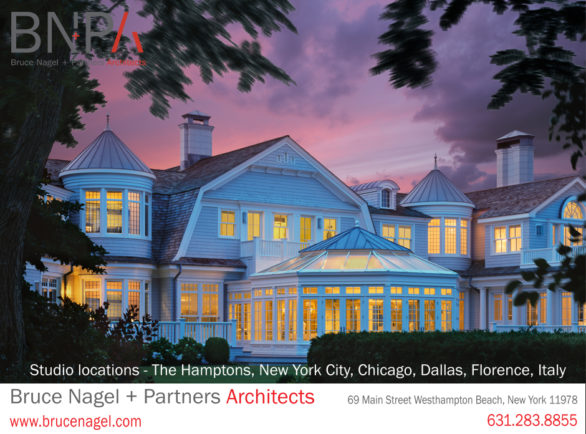UP CLOSE
Playing with Perception
American artist Frederick John Eversley, who worked as an engineer for NASA before turning to art, invites viewers to think about how they perceive his 1970 sculpture Untitled. As you look at the work, consider these questions:
- What colors do you see? Can you name them?
- Trace the shape of the work with your eyes. How would you describe its shape?
- How do you think this work was made?
|
 |
|
| Eversley’s sculpture is a feat of engineering. To make it, he poured polyester resin, a type of clear plastic, into a cylinder mold on a rotating potter’s wheel. As the wheel spun and the resin cured, Eversley added violet, amber, and blue dyes at timed intervals to keep each color distinct. He then shaped the resin into a parabolic form and polished the surface by hand, creating the effect of a fish-eye lens.
—– |
| Imagine walking around this colorful and transparent object. Eversley, a Black artist and scientist, used plastic materials, optics, and light to celebrate color and explore it as a phenomenon that is both personal and dynamic. |
|
 |
| When the Gallery reopens, this work will again be among those featured on public tours of the Wurtele Study Center. Learn more. |
|
| ~~~~~~~~~~~~~~~~~~~~~~~~~~~~~~~~ |
|
NEWS
Conserving Space and Time: Edwin Austin Abbey’s Cartoon for The Passage of the Hours
|
 |
|
| —–
For an upcoming exhibition of the work of the American artist Edwin Austin Abbey (1852–1911), several of his oil studies and works on paper are undergoing treatment in the Shared Conservation Laboratory at Yale West Campus. One of Abbey’s largest and most stunning works is a 12-foot-round study for The Passing of the Hours (ca. 1904–11). Conceived as a half-scale study for a ceiling mural now in the Pennsylvania State Capitol in Harrisburg, the painting depicts 24 figures, each representing an hour of the day, striding around the perimeter of a sky filled with the sun, moon, stars, and constellations.
—– |
|
| Read more about the challenges of treating this large, delicate work. |
|
| ~~~~~~~~~~~~~~~~~~~~~~~~~~~~~~~~ |
|
|
|
LEARN MORE ABOUT…
Lumia
Lumia were the invention of Danish-born American artist Thomas Wilfred (1889–1968). Lumia are silent, kinetic works in which electrical, reflective, and mechanical elements direct light onto translucent screens, “evoking something different to everyone, whether it be deep space, the Northern Lights, or psychedelic light shows,” says curator Keely Orgeman. Wilfred’s unprecedented works prefigured the field of light art in America.
—– |
|
FREE EXCERPT
Lumia: Thomas Wilfred and the Art of Light
Read the foreword by artist James Turrell, who recounts his first experience seeing the art of Thomas Wilfred, and the essay by curator Keely Orgeman. Buy the publication from Yale University Press.
—– |
|
|
EXPLORE THE COLLECTION
Light Art for the Home
Unit #50, Elliptical Prelude and Chalice
1928
Metal, fabric, glass, and electrical and lighting elements on a maple table
—– |
|
| Unit #50, Elliptical Prelude and Chalice functions simply as a piece of furniture until its owner flips a switch to activate the work’s mechanism. Inside the box, a bulb transmits light through two hand-painted, rotating discs (below). Light rays then travel through a set of cones—one on the underside of the table, the other inside the body of the lamp—and, finally, through the top of the lampshade. The ceiling, thus transformed into a screen, fills with a vortex of rippling clouds that swirl around a central oculus, resembling the eye of a storm.
—– |
|
|
| ~~~~~~~~~~~~~~~~~~~~~~~~~~~~~~~~ |
|
|
|
| ~~~~~~~~~~~~~~~~~~~~~~~~~~~~~~~~ |
|
|
|
MAKE A DIFFERENCE
—–
Support the Gallery’s Annual Fund
—–
Gifts to the Annual Fund strengthen the Gallery’s ability to respond to uncertain times. To everyone who has a made a recent gift, we say thank you. The ability to gather our online resources and offer them to a broad audience is made possible by our generous donors. |
|
|
| ~~~~~~~~~~~~~~~~~~~~~~~~~~~~~~~~ |
|
|
|
| The Yale University Art Gallery is currently closed until further notice. The Gallery is working in close collaboration with Yale University leadership to safeguard against the spread of coronavirus disease 2019 (COVID-19) and to ensure the safety of our visitors and staff. Please continue to check our website in the coming days and weeks for additional information or changes to the Gallery’s public services. Learn more.
~~~~~~~~~~~~~~~~~~
|
|
|
|

